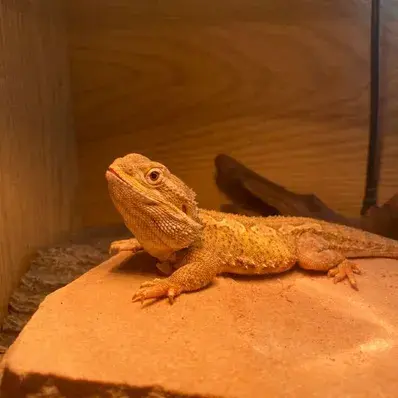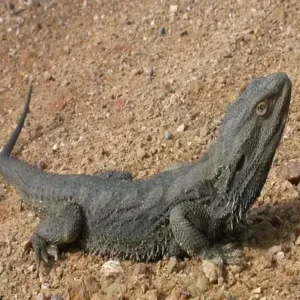History/Origin
Rankin’s Dragon, scientifically named Pogona rankini, hails from the arid landscapes of Australia, specifically in the Northern Territory and Queensland. Discovered and documented in the 1980s, the credit for their initial description goes to the eminent Australian herpetologist Dr. Eric R. Worrell. Dr. Worrell’s research shed light on the distinct characteristics and behaviors of this species, contributing significantly to our understanding of Australia’s diverse reptilian fauna. This relatively recent discovery underscores the ongoing exploration and appreciation of the rich biodiversity within the continent’s unique ecosystems.
Personality
Rankin’s Dragons are beloved for their gentle demeanor and easy handling, making them popular among reptile lovers. They are naturally calm and can be socialized early, fostering strong bonds with their owners. These dragons exhibit curiosity and responsiveness, adding an engaging dynamic to pet ownership. Their small size belies a captivating presence, making them ideal companions for families seeking low-maintenance pets. With proper care, Rankin’s Dragons flourish in domestic settings, enriching the lives of their human counterparts with their charming behaviors.
Physical Appearance
Let’s take a look at the physical characteristics of the Rankin’s Dragon in detail.
- Size: Rankin’s Dragons typically measure between 10 to 12 inches in length, making them smaller than some other dragon species.
- Color: Their coloration varies but often includes shades of brown, gray, and tan, blending in with their natural desert habitat.
Rankin Dragon Vs. Bearded Dragon
Here’s a comparison table between Rankin’s Dragon and Bearded Dragon to avoid confusion between these two types:
| Feature | Rankin’s Dragon | Bearded Dragon |
| Scientific Name | Pogona rankini | Pogona vitticeps |
| Origin | Australia, specifically NT, QLD | Australia, various regions |
| Size | Smaller, typically 10-12 inches | Larger, up to 20 inches |
| Temperament | Generally docile and calm | Generally docile and friendly |
| Coloration | Earthy tones, brown, gray, tan | Variable, including red, orange, yellow |
| Habitat Preference | Arid regions, savannas | Varied, including deserts, woodlands, and scrublands |
| UVB Requirements | Necessary for calcium absorption | Necessary for calcium absorption |
| Heat Source | Requires basking spots and may benefit from ceramic heat emitter | Requires basking spots and may benefit from ceramic heat emitter |
Types of Bearded Dragons
There are several types of bearded dragons, each with its own unique characteristics and traits. Some of the common types include:
- Inland/ Central Bearded Dragon (Pogona vitticeps): The most common and widely kept type of bearded dragon, known for its friendly disposition and relatively large size. A red-bearded dragon is not a distinct species or type but rather a color morph of the Central Bearded Dragon (Pogona vitticeps). Bearded dragons come in various color variations, including red, orange, yellow, and even translucent or hypo (reduced pigmentation) forms.
- Rankin’s Dragon (Pogona henrylawsoni): Smaller in size compared to the Central Bearded Dragon, Rankin’s Dragons are popular for their manageable size and gentle temperament.
- Lawson’s Dragon (Pogona henrylawsoni): Often confused with Rankin’s Dragons, Lawson’s Dragons are another smaller species known for their unique appearance and docile nature.
- Pygmy Bearded Dragon (Pogona minor): The smallest type of bearded dragon, Pygmy Beardies are compact in size and often favored by enthusiasts with limited space.
- Dwarf Bearded Dragon: This term may refer to smaller individuals within the Central Bearded Dragon species or to other smaller variants bred selectively for their size.
- German Giant Bearded Dragon: Bred for their large size, German Giants are a selectively bred variant of the Central Bearded Dragon, known for their robust build and impressive size.
Gender Differences
Distinguishing between male and female Rankin’s Dragons involves observing key anatomical and behavioral traits. Males typically exhibit larger heads and broader bodies compared to females. This physical disparity becomes more apparent as they mature. During mating displays, males showcase their vividly colored markings, emphasizing their throat and beard regions. These vibrant displays serve as courtship rituals to attract potential mates. On the other hand, females generally have more streamlined bodies with a slightly smaller head size. While both genders share similar base colors, the pronounced physical differences become particularly evident during breeding seasons. These disparities offer enthusiasts valuable cues to identify and understand the gender dynamics within the adult Rankin’s Dragon population.
Feed/Nutrition
Rankin’s Dragons require a balanced diet to thrive, incorporating both animal protein and plant matter to meet their nutritional needs effectively. Insects
- Crickets: Rich in protein, essential for growth and muscle development.
- Mealworms: Offer a good source of protein and fat, aiding in energy production.
- Waxworms: High in fat content, providing supplemental energy for active periods.
Leafy Greens and Vegetables
- Kale: Packed with vitamins A, C, and K, promoting overall health and immune function.
- Collard Greens: Excellent source of calcium and fiber, vital for bone strength and digestion.
- Squash: Provides essential vitamins and minerals, including potassium and vitamin B6, supporting metabolic functions.
Calcium Supplementation
- Crucial for bone health and preventing metabolic bone disease.
- Offer calcium-rich supplements such as calcium carbonate powder or cuttlebone, ensuring adequate intake.
Health
Rankin’s Dragons are susceptible to several common health issues that require vigilant monitoring and proactive care to prevent and manage effectively. Metabolic Bone Disease (MBD)
- Caused by calcium deficiency, improper UVB exposure, or phosphorus imbalance.
- This leads to weakened bones, deformities, and lethargy.
- Preventable through proper supplementation, UVB bulb lighting, and a calcium-rich diet.
Respiratory Infections
- Often triggered by poor husbandry conditions, such as inadequate temperatures or high humidity levels.
- Symptoms include wheezing, nasal discharge, and lethargy.
- Treatment involves veterinary care, antibiotics, and improving environmental conditions.
Parasites
- Internal parasites like pinworms and coccidia can affect digestive health.
- External parasites such as mites and ticks cause skin irritation and discomfort.
- Regular fecal exams and habitat sanitation help prevent parasite infestations.
Care and Grooming
Ensuring the well-being of Rankin’s Dragons involves meticulous attention to their living conditions and overall health. Enclosure Size Requirements
- Provide a spacious vivarium with branches and rocks for climbing and basking.
- Create temperature gradients by incorporating heat sources such as ceramic heat emitter and cooler areas.
- Include hiding spots to offer a sense of security.
Lighting and Temperature
- Use full-spectrum UVB lighting to support calcium absorption and prevent metabolic bone disease.
- Maintain a temperature range of 85-95°F (29-35°C) during the day, with a slight drop at night.
Substrate and Hygiene
- Choose a substrate like reptile carpet or paper towels for easy cleaning.
- Perform regular spot cleaning to remove waste and uneaten food.
- Change the substrate periodically to maintain cleanliness and prevent bacterial growth.
Grooming
- Monitor their health by observing eating habits, behavior, and overall appearance.
- Check for signs of shedding and provide proper humidity if necessary.
- Trim sharp nails when needed, and ensure proper hydration through a shallow water dish.
Rescue Groups
Several reptile rescue organizations and shelters specialize in caring for Rankin’s Dragons and other reptiles in need of rehoming. These groups often provide education, rehabilitation, and adoption services for abandoned or neglected reptiles.
Rankin's Dragon for Sale
Reputable breeders and pet stores may offer Rankin’s Dragons for sale. It’s essential to research and choose a responsible breeder or retailer that prioritizes the health and welfare of the reptiles.
Interesting Facts
- Rankin’s Dragons are named after the Australian herpetologist Dr. Steve Rankin.
- Rankin’s Dragon dumpy dragon can change color in response to environmental stimuli, such as temperature and mood.
- These dragons have a unique “beard” under their chin that they can puff out when feeling threatened.
- Rankin’s Dragons are skilled climbers, using their claws and strong limbs to navigate their surroundings.
- Despite their small size, they have a hearty appetite and can consume a significant amount of food relative to their body size.
- In the wild, they may bask in the sun for hours to regulate their body temperature and aid in digestion.
Best For
Rankin’s Dragons make excellent pets for reptile enthusiasts of all experience levels. Their manageable size, calm demeanor, and relatively low maintenance requirements make them suitable companions for responsible pet owners.
Top Names
| Male Rankin Dragon Names | Female Rankin Dragon Names |
| Spike | Ember |
| Draco | Luna |
| Rex | Ruby |
| Thor | Stella |
| Rocky | Willow |










